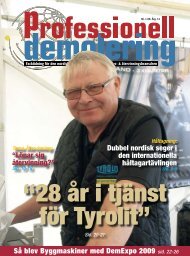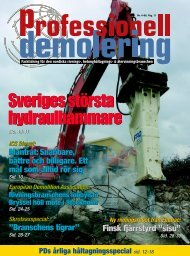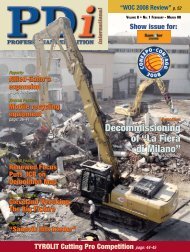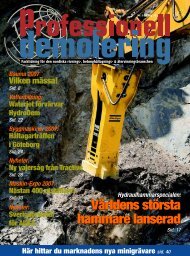Hitachi's Silver Lining - Pdworld.com
Hitachi's Silver Lining - Pdworld.com
Hitachi's Silver Lining - Pdworld.com
- No tags were found...
Create successful ePaper yourself
Turn your PDF publications into a flip-book with our unique Google optimized e-Paper software.
The success factors of aproductive wall sawing jobWall sawing hasevolved throughoutthe last couple of decades.The first toolswere heavy and bulky,mainly hydraulic systemswith practicallyno automation. Todaywe observe a cleartendency to more<strong>com</strong>pact tools that aredriven with electrichigh frequency technology.54 PDi • Issue 2 • May - June 2011This technology offers a higher degree of efficiencythan conventional hydraulic systems and a muchlighter system weight.In the last decade the race in the wall sawing industrywas dominated by building the saw with the highestperformance of the market. This tendency has certainlybrought productivity to another level and the effectivesawing time has been reduced to a level that it only takesa relatively small share of the total application.On an average sawing job a saw is running only a fewhours per day, the rest of it is spent with transportation,installation and removal of the equipment. This means,on a regular working day an operator will be sawing lessthan 20% of the time.An important leverage to improve the total applicationtime is not depending anymore so much on the saw speed,but mainly on how fast the equipment is being brought tothe jobsite and installed.Especially on jobsites such where single doors or windowopenings have to be cut out and where the saw has tobe constantly moved from one floor to the next, the easeof transport and installation <strong>com</strong>es much more into playthan the sawing performance of the equipment.Transport and set up timegets more importantTo reduce effort a trolley can facilitate a lot the transportfrom the van to the sawing location. Manufacturers offerconvenient transport trolleys that can take all the necessarysawing material and be brought to the desired location bya single person with much less effort in one go. Dependingon the distance this can drastically reduce the transporttime and will save energyof the operator. Once the sawis on the desired location it has to beinstalled. This part of the application takesup a big share of total application. A smart sawingsystem should be able to be fast and easily installed.Latest hype – new wall saw from HiltiFewer and handier parts make a system more efficient. Assome of the saws are still quite heavy, some manufacturerswork with a modular system, where, for example, thesaw head can be dismantled into smaller, more handyparts. This brings certainly some advantages, as the single<strong>com</strong>ponent can be easier transported and installed, buthas also its downside as the operator has one <strong>com</strong>ponentmore that he has to assemble or dismantle.The latest hype is the new wall saw of Hilti, the DST10-E. A regular high frequency wall saw needs a separateelectro box that makes the electrical conversion to high frequency.This new saw integrates the electronics already inits saw head, so no separate e-box is needed. This conceptsaves time when it <strong>com</strong>es to transport and installation ofthe system and will improve total application time muchmore efficiently than a higher performing saw. The realtime gain is achieved with the reduction of the transportand set up time of the equipment, especially if the totalamount of sawing is 2m 2 and less.
















